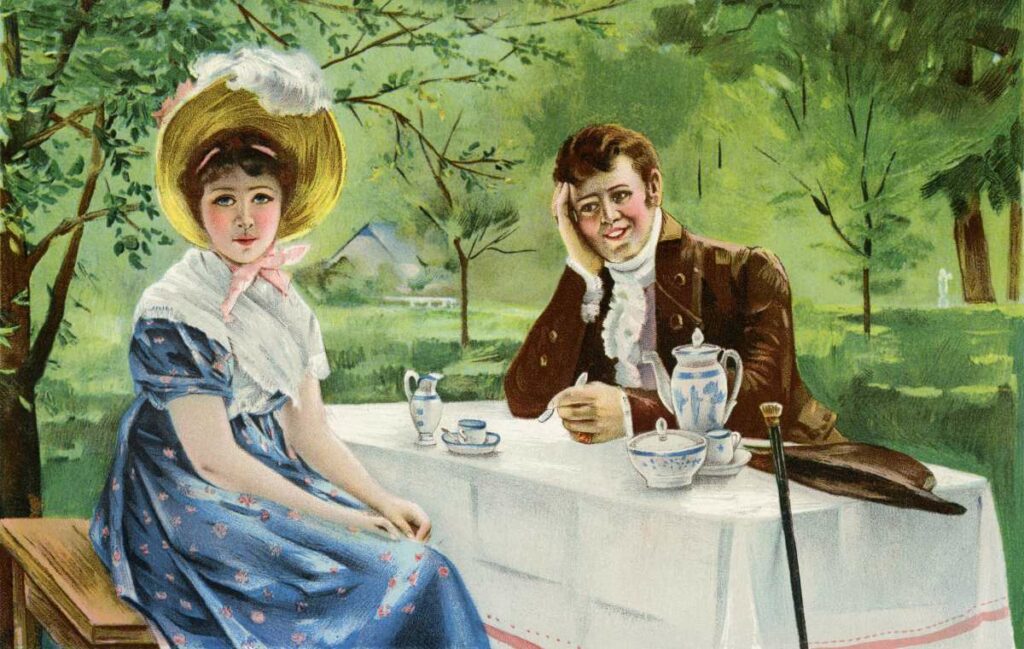This past March saw new seasons of such fan-favorite period pieces as Bridgerton, The Gilded Age, and Sanditon return to television. Like many, I binge-watched each show, savoring the costumes and settings and hoping my favorite characters would find the love they sought in an age when neither love nor personal choice was required for a marriage arrangement to be made.
At their essence, and aside from their backdrops and era, these shows are about the culture of courtship; an emerging 19th-century custom primarily among Europeans bucking the tradition of arranged marriage in favor of suitable, parental-approved free choice. This required that the couple first spend a period of supervised time together to get to know each other and determine lifelong compatibility; thus, “The Courtship.”
In period-era dramas, courtship is romanticized; carriage rides through the country, chaperoned walks on the promenade, evenings spent in the company of others at balls and dinner parties…however, more than mere flirtations, these courtships were high-stakes opportunities on both sides of the aisle, and not something to be entered into lightly or frivolously for fear of damaging one’s reputation and therefore eligibility. That’s what makes courtship so exciting, dangerous, relatable and deliciously entertaining as a plotline.
In most cultures up through the 19th-century, marriages were contracts typically arranged by parents or family members as a business transaction. Often, the bride and groom did not meet until their wedding day. Arranged marriages united families, secured wealth, built political alliances, and perpetuated lineage. In the words of Tina Turner, “What’s love got to do with it?”
The concept of arranged marriages goes back thousands of years, and there are plenty of stories throughout history and literature about the practice. Fast forward to the 1500s and arranged marriages still occurred, especially among royalty and the upper classes in Europe and Asia. The middle classes elsewhere in the world soon followed in an effort to improve their standing in society.
In Western European society, arranged marriages were the norm until the late 1700s, when “personal choice of partners had replaced arranged marriages as a social ideal, and individuals were encouraged to marry for love,” according to Stephanie Coontz, author of “Marriage, a History.” Still, social class, wealth, and suitability continued to place restrictions on a woman’s free will to choose the man of her dreams.
Arranged marriages among migrant families in the United States were common well into the first half of the 20th century as a way to bring wives and their families over from their hometowns. These were sometimes referred to as “picture-bride marriages” because the bride and groom knew each other only through the exchange of photographs before the day of their marriage. As immigrants assimilated as Americans, arranged marriages shifted to quasi-arranged marriages where parents or friends made introductions and the couple met before the marriage, thus ensuring that marriage strengthened rather than weakened cultural bonds and traditions.
Mail Order Brides were another American marriage phenomenon. The West drew men with the promise of fortune, adventure, and a new beginning. Women saw moving west as a chance for the same thing, literally providing a ticket to a new or better life. Many were more than willing to travel west to marry an unknown man, often solicited through advertisements in newspapers. With the low ratio of women to men, many western states made a deliberate effort to recruit women by promising them liberal women’s legislation about retaining ownership of property upon marriage, the legal right to initiate divorce, and the ability to vote.
Although The Marriage Law of 1950 effectively outlawed arranged marriages (it also enabled women to divorce their husbands, and made it illegal for men to have multiple wives), it is still practiced today among certain religions and cultures, in this country, and more so around the world. In fact, high divorce rates among couples of choice have many young people in certain cultures today returning to their elders and family members to help make formal introductions if not outright arranged marriages. More common, though, is an introduction and then a period of courtship that allows the couple, however they become connected, to get to know each other before their wedding day.
In earlier centuries, young adults were expected to court with the intention of finding marriage partners, rather than for social reasons; however, by the 1920s, dating for fun was becoming an expectation, and by the 1930s, it was assumed that any popular young person would have lots of dates before agreeing to marry.
As the decades progressed, proprietary was replaced by a sexual revolution that added more than social compatibility into the courtship mix. The second half of the 20th-century also saw more young women choosing to delay marriage to have a life and build a career before settling down, and young people, in general, taking a more cynical view of the institution.
Courtship today is best stated as an antique word. Glances around a ballroom to find someone that catches your eye or discrete introductions from family members have been replaced by dating apps that allow you to swipe through potential candidates based on an algorithm of compatibility. Candidates can then be pre-screened based on their social media profiles. Courtship, too, is changing. Technologies such as Zoom allow people all over the world to make virtual, personal connections and carry on relationships. Handwritten love letters, once cherished and forever saved, have been replaced by the sending of texts and online chatting.
While the practice of courtship continues to change with the times, the intent behind the practice remains unchanged, as does the hope we all share in finding love and celebrating the occasion with the wedding of our dreams.





Related posts: